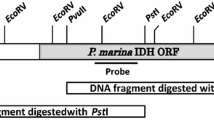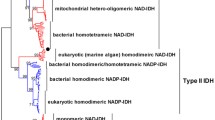Abstract
Microcystis aeruginosa is the key symptom of water eutrophication and produces persistent microcystins. Our special attention was paid to the isocitrate dehydrogenase (IDH) of M. aeruginosa (MaIDH) because it plays important roles in energy and biosynthesis metabolisms and its catalytic product 2-oxoglutarate provides the carbon skeleton for ammonium assimilation and also constitutes a signaling molecule of nitrogen starvation in cyanobacteria. Sequence alignment showed that MaIDH shared significant sequence identity with IDHs from other cyanobacteria (>80 %) and other bacteria (>45 %). The subunit molecular weight of MaIDH was determined to be 52.6 kDa by filtration chromatography, suggesting MaIDH is a typical homodimer. The purified recombinant MaIDH was completely NADP+-dependent and no NAD+-linked activity was detectable. The K m values for NADP+ were 32.24 and 71.71 μM with Mg2+ and Mn2+ as a sole divalent cation, and DL-isocitrate linked K m values were 32.56 μM (Mg2+) and 124.3 μM (Mn2+), respectively. As compared with Mn2+, MaIDH showed about 2.5-times and 4-times higher affinities (1/K m) to NADP+ and dl-isocitrate with Mg2+. The optimum activity of MaIDH was found at pH 7.5, and its optimum temperature was 45 °C (Mn2+) and 50 °C (Mg2+). Heat-inactivation studies showed that heat treatment for 20 min at 45 °C caused a 50 % loss of enzyme activity. MaIDH was completely divalent cation dependent as other typical dimeric IDHs and Mn2+ was its best activator. Our study is expected to give a better understanding of primary metabolic enzymes in M. aeruginosa. This would provide useful basic information for the research of controlling the blue-green algae blooms through biological techniques.






Similar content being viewed by others
References
Zhu GP, Golding GB, Dean AM (2005) The selective cause of an ancient adaptation. Science 307(5713):1279–1282
Ceccarelli C, Grodsky NB, Ariyaratne N, Colman RF, Bahnson BJ (2002) Crystal structure of porcine mitochondrial NADP+-dependent isocitrate dehydrogenase complexed with Mn2+ and isocitrate. Insights into the enzyme mechanism. J Biol Chem 277(45):43454–43462
Xu X, Zhao J, Xu Z, Peng B, Huang Q, Arnold E, Ding J (2004) Structures of human cytosolic NADP-dependent isocitrate dehydrogenase reveal a novel self-regulatory mechanism of activity. J Biol Chem 279(32):33946–33957
Jo SH, Son MK, Koh HJ, Lee SM, Song IH, Kim YO, Lee YS, Jeong KS, Kim WB, Park JW, Song BJ, Huh TL (2001) Control of mitochondrial redox balance and cellular defense against oxidative damage by mitochondrial NADP+-dependent isocitrate dehydrogenase. J Biol Chem 276(19):16168–16176
Kim SY, Park JW (2003) Cellular defense against singlet oxygen-induced oxidative damage by cytosolic NADP+-dependent isocitrate dehydrogenase. Free Radic Res 37(3):309–316
Kim HJ, Kang BS, Park JW (2005) Cellular defense against heat shock-induced oxidative damage by mitochondrial NADP+-dependent isocitrate dehydrogenase. Free Radic Res 39(4):441–448
Lee SM, Koh HJ, Park DC, Song BJ, Huh TL, Park JM (2002) Cytosolic NADP+-dependent isocitrate dehydrogenase status modulates oxidative damage to cells. Free Radic Biol Med 32(11):1185–1196
Yan H, Parsons DW, Jin G, McLendon R, Rasheed BA, Yuan W, Kos I, Batinic-Haberle I, Jones S, Riggins GJ, Friedman H, Friedman A, Reardon D, Herndon J, Kinzler KM, Velculescu VE, Vogelsetein B, Bigner DD (2009) IDH1 and IDH2 mutations in gliomas. N Engl J Med 360(21):765–773
Gross S, Cairns RA, Minden MD, Driggers EM, Bittinger MA, Jang HG, Sasaki M, Jin S, Schenkein DP, Su SM, Dang L, Fantin VR, Mark TW (2009) Cancer-associated metabolite 2-hydroxyglutarate accumulates in acute myelogenous leukemia with isocitrate dehydrogenase 1 and 2 mutations. J Exp Med 207(2):339–344
Krell D, Assoku M, Galloway M, Mulholland P, Tomlinson I, Bardella C (2011) Screen for IDH1, IDH2, IDH3, D2HGDH and L2HGDH mutations in glioblastoma. PLoS One 6(5):e19868
Dang L, White DW, Gross S, Bennett BD, Bittinger MA, Driggers EM, Fantin VR, Jang HG, Jin S, Keenan MC, Marks KM, Prins RM, Ward PS, Yen KE, Liau LM, Rabinowitz JD, Cantley LC, Thompson CB, Vander Heiden MG, Su SM (2009) Cancer-associated IDH1 mutations produce 2-hydroxyglutarate. Nature 462:739–744
Jacoby JM, Collier DC, Welch EB, Hardy FJ, Crayton M (2000) Environmental factors associated with a toxic bloom of Microcystis aeruginosa. Can J Fish Aquat Sci 57(1):231–240
Vézie C, Rapala J, Vaitomaa J, Seitsonen J, Sivonen K (2002) Effect of nitrogen and phosphorus on growth of toxic and nontoxic microcystis strains and on intracellular microcystin concentrations. Microb Ecol 43(4):443–454
Ito E, Takai A, Kondo F, Masui H, Imanishi S, Harada K (2002) Comparison of protein phosphatase inhibitory activity and apparent toxicity of microcystins and related compounds. Toxicon 40(7):1017–1025
Carmichael WW (1992) Cyanobacteria secondary metabolites-the cyanotoxins. J Appl Bacteriol 72(6):445–459
Ni LX, Acharya K, Hao XY, Li SY (2012) Isolation and identification of an anti-algal compound from Artemisia annua and mechanisms of inhibitory effect on algae. Chemosphere 88(9):1051–1057
Paerl HW, Hall NS, Calandrino ES (2011) Controlling harmful cyanobacterial blooms in a world experiencing anthropogenic and climatic-induced change. Sci Tot Environ 409(10):1739–1745
Rhee JR, Dahms HU, Choi BS, Lee JS, Choi IY (2012) Identification and analysis of whole microcystin synthetase genes from two Korean strains of the cyanobacterium Microcystis aeruginosa. Genes Genom 34(4):435–439
Pearce J, Leach CK, Carr NG (1969) The incomplete tricarboxylic acid cycle in the blue-green alga Anabaena variabilis. J Gen Microbiol 55(3):371–378
Zhang S, Bryant DA (2011) The tricarboxylic acid cycle in cyanobacteria. Science 334(6062):1551–1553
Kuniyoshi TM, Gonzalez A, Lopez-Gomollon S, Valladares A, Bes MT, Fillat MF, Peleato ML (2011) 2-oxoglutarate enhances NtcA binding activity to promoter regions of the microcystin synthesis gene cluster. FEBS Lett 585(24):3921–3926
Zhao MX, Jiang YL, He YX, Chen YF, Teng YB, Chen Y, Zhang CC, Zhou CZ (2010) Structural basis for the allosteric control of the global transcription factor NtcA by the nitrogen starvation signal 2-oxoglutarate. Proc Natl Acad Sci USA 107(28):12487–12492
Martin-Luna B, Hernandez JA, Bes MT, Fillat MF, Peleato ML (2006) Identification of a Ferric uptake regulator from Microcystis aeruginosa PCC7806. FEMS Microbio Lett 254(1):63–70
Larkin MA, Blackshields G, Brown NP, Chenna R, McGettigan PA, McWilliam H, Valentin F, Wallace IM, Wilm A, Lopez R, Thompson JD, Gibson TJ, Higgins DG (2007) Clustal W and Clustal X version 2.0. Bioinformatics 23(21):2947–2948
Gouet P, Courcelle E, Stuart DI, Métoz F (1999) ESPript: analysis of multiple sequence alignments in PostScript. Bioinformatics 15(4):305–308
Kim TK, Lee P, Colman RF (2003) Critical role of Lys212 and Tyr140 in porcine NADP+-dependent isocitrate dehydrogenase. J Biol Chem 278(49):49323–49331
Pardo MA, Llama MJ, Serra JL (1999) Purification, properties and enhanced expression under nitrongen stravation of the NADP+-isocitrate dehydrogenase from the cyanobacterium Phormidium laminosum. Biochim Biophys Acta 1431(1):87–96
Muro-Pastor MI, Florencio FJ (1994) NADP+-isocitrate dehydrogenase from the cyanobacterium Anabaena sp. strain PCC 7120: purification and characterization of the enzyme and cloning, sequencing, and disruption of the icd gene. J Bacteriol 176(9):2718–2726
Friga GM, Farkas GL (1981) Isolation and properties of isocitrate dehydrogenase from Anacystis nidulans. Arch Microbiol 129(5):331–334
Schrautemeier B, Böhme H (1985) A distinct ferredoxin for nitrogen fixation isolated from heterocysts of the cyanobacterium Anabaena variabilis. FEBS Lett 184(2):304–308
Neuer N, Bothe H (1983) Anaplerotic reactions in Anabaena cylindrica. FEBS Lett 158(1):79–83
Muro-Pastor MI, Florencio FJ (1992) Purification and properties of NADP+-isocitrate dehydrogenase from the unicellular cyanobacterium Synechocystis sp. PCC 6803. Eur J Biochem 203(1–2):99–105
Singh SK, Miller SP, Dean A, Banaszak LJ, LaPorte DC (2002) Bacillus subtilis isocitrate dehydrogenase. A substrate analogue for Escherichia coli isocitrate dehydrogenase kinase/phosphatase. J Biol Chem 277(9):7567–7573
Jennings GT, Minard KI, McAlister-Henn L (1997) Expression and mutagenesis of mammalian cytosolic NADP+-specific isocitrate dehydrogenase. Biochemistry 36(44):13743–13747
Reeves HC, Daumy GO, Lin CC, Houston M (1972) NADP+-specific isocitrate dehydrogenase of Escherichia coli. Biochim Biophys Acta 258(1):27–39
Kosten S, Huszar VLM, Bécares E, Costa LS, Van Donk E, Hansson LA, Jeppesen E, Kruk C, Lacerot G, Mazzeo N, Meester LD, Moss B, Lürling M, Nõges T, Romo S, Scheffer M (2012) Warmer climates boost cyanobacterial dominance in shallow lakes. Glob Change Biol 18(1):118–126
Pardo MA, Llama MJ, Serra JL (1998) Thermal stabilization by its ligands of NADP+-isocitrate dehydrogenase from the thermophilic cyanobacterium Phormidium laminosum. Biotech 15:229–234
Papen H, Neuer G, Refaian M, Bothe H (1983) The isocitrate dehydrogenase from cyanabacteria. Arch Microbiol 134(1):73–79
Stoddard BL, Dean A, Koshland DE Jr (1993) Structure of isocitrate dehydrogenase with isocitrate, nicotinamide adenine dinucleotide phosphate, and calcium at 2.5 Å resolution: a pseudo-michaelis ternary complex. Biochemistry 32(36):9310–9316
Acknowledgments
This research was supported by funds from the National High Technology Research and Development Program (“863” Program: 2012AA02A708), the National Natural Science Foundation of China (31170005; 30900243), Specialized Research Fund for the Doctoral Program of Higher Education of China (20113424110004), the Fund of State Key Laboratory of Genetics Resources and Evolution from Kunming Institute of Zoology (Chinese Academy of Sciences, CAS) (GREKF11-07), Anhui Provincial Key Laboratory of the Conservation and Exploitation of Biological Resources and Program for Innovative Research Team in Anhui Normal University.
Author information
Authors and Affiliations
Corresponding author
Rights and permissions
About this article
Cite this article
Jin, MM., Wang, P., Li, X. et al. Biochemical characterization of NADP+-dependent isocitrate dehydrogenase from Microcystis aeruginosa PCC7806. Mol Biol Rep 40, 2995–3002 (2013). https://doi.org/10.1007/s11033-012-2371-8
Received:
Accepted:
Published:
Issue Date:
DOI: https://doi.org/10.1007/s11033-012-2371-8




